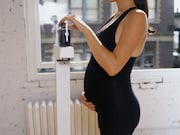For second pregnancy, risk higher among low-risk women with high, persistent air pollution exposure
THURSDAY, Oct. 3, 2019 (HealthDay News) — Persistent or increased exposure to high levels of air pollutants may increase the risk for preterm birth (PTB), particularly among women without a prior preterm birth, according to a study published online Sept. 12 in the International Journal of Environmental Research and Public Health.
Pauline Mendola, Ph.D., from the Eunice Kennedy Shriver National Institute of Child Health and Human Development (NICHD) in Bethesda, Maryland, and colleagues used modified Community Multiscale Air Quality models linked to the NICHD Consecutive Pregnancy Study to evaluate the association between PTB and air pollutants for two consecutive pregnancies. The analysis used electronic medical records for delivery admissions for 50,005 women with singleton births in 20 Utah-based hospitals (2002 to 2010).
The researchers found that second-pregnancy PTB risk was elevated when exposure stayed high for sulfur dioxide (32 percent), ozone (17 percent), nitrogen oxides (24 percent), nitrogen dioxide (43 percent), carbon monoxide (31 percent), and particles <10 microns (29 percent) compared with consistently low exposure. When pollution exposure increased or stayed high, women with a repeat PTB had less of an increased PTB risk (19 to 21 percent) compared with women without a prior PTB (22 to 79 percent).
“Area-level changes in air pollution exposure appear to have important consequences in consecutive pregnancies with increasing exposure associated with higher risk,” the authors write.
Copyright © 2019 HealthDay. All rights reserved.








